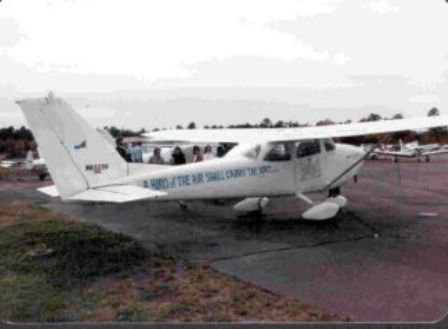Along with the establishment of Fields of the Wood and the CPMA auxiliary, an interest was developed in an airplane program for the Church. A connection between the arising of the Church and the first airplane flight had long been recognized as a prophetical fulfillment. A. J. Tomlinson often wrote and preached about the two events as being related in the fulfillment of Bible prophecy.
The Church of Prophecy Marker Association was adopted by the Church in 1941, and Grady R. Kent became the first General Secretary of the CPMA auxiliary. He was a man with a flamboyant personality and always did things in a big way. It did not take long for his interest in flying to become connected to the spread of the gospel and making the Church known to the public. His enthusiasm helped to create a large fleet of airplanes across the nation to spread the Word through local programs at airports, preaching and flying over towns and dropping tracts from the air to create an interest in the gospel and advertise the Church. This program was referred to as “Wings of Prophecy” and the fleet of planes became known as the “White Angel Fleet.” By 1952 the fleet of planes had grown to 88 planes with over 100 licensed pilots. One of the planes is parked in a pavilion in Fields of the Wood to emphasize this aspect of the work.
The first literature drop from a plane took place in the summer of 1935, several years before the advent of this program, in the state of Wisconsin by State Overseer F. R. Olson. One of the most outstanding literature drops from a plane took place in 1951 in Portsmouth, Ohio, with 50,000 tracts being dropped on the city. “The feat created great interest in residents in certain areas, and lawyers, judges and some professors of the University of Cincinnati came to investigate and seek Scriptural support” (Upon This Rock—Vol. 3, p. 566.)
The City of Cleveland, Tennessee, established its Municipal Airport on Highway 11, about three miles north of the city. A few acres of the original orphanage farm, which later became the campus for Tomlinson College, became an extension of the airport runway, thus dividing the property into two major sections. The General Church bought a twin-engine Cessna 190 airplane in August of 1952, which was kept at this airport. This plane was used in connection with the business of the Church and especially in flying the General Overseer to events more quickly than ground travel allowed.
As time progressed, many municipalities adopted litter laws restricting such events as described above. General interest began to wane toward the late 1950s, due in part to Grady Kent leaving the Church to establish a movement of his own. He began to promote radical ideas and programs within his group that brought embarrassment to the Church. He developed a motorcycle brigade as one example and encouraged their members to decorate their cars, which were usually white in color, with bizarre designs to draw attention to their program. The airplane program known as “Wings of Prophecy” began dying out, and today, the use of commercial air travel by the ministers of the Church is considered sufficient in fulfilling the scriptural injunction: “for a bird of the air shall carry the voice, and that which hath wings shall tell the matter” (Eccl. 10:20).


